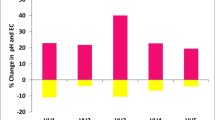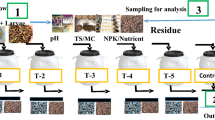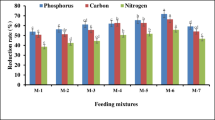Abstract
A new bioconversion-composting process of golden needle mushroom (Flammulina velutipes) root waste was established using black soldier fly larvae (BSFL) to produce added-value biomass and organic fertilizer. The entire process included two stages: BSFL conversion and conventional composting, which lasted 40 days. After a 26-day bioconversion, a considerable quantity of BSFL was obtained, which could be used to produce the protein feed, chitin, antibacterial peptide, biodiesel and so on. The bioconversion parameters of waste reduction rate and BSFL conversion rate were 54.8 ± 0.4 and 5.06 ± 0.27%, respectively. Following the 14-day conventional composting, the mushroom root waste turned into an organic fertilizer. The moisture, organic matter, total nitrogen, total phosphorus, and total potassium concentrations of the obtained fertilizer were 29.3 ± 0.9, 76.0 ± 1.7, 2.74 ± 0.09, 2.07 ± 0.06, and 1.34 ± 0.15%, respectively. The germination index was 65.7 ± 3.2% for Chinese cabbage and 52.9 ± 1.3% for rapeseed. To accelerate bioconversion, increase output of larvae biomass and shorten the developing time of BSFL, two auxiliary materials, nitrogen source, namely, bran and kitchen wastes, were mixed with mushroom roots. Both were significantly effective, and the recommended percentage was 40%. In that case, the developing time reduced to approximately 15–16 days, and the BSFL conversion rate increased by 31.2–172.7%. Accordingly, one simple process flowchart was drawn, and the output was estimated.





Similar content being viewed by others
References
Xia, Z.: Preparation of the oligosaccharides derived from Flammulina velutipes and their antioxidant activities. Carbohydr. Polym. 118, 41–43 (2015). doi:10.1016/j.carbpol.2014.10.074
Kang, L.-z., Zeng, X.-l., Ye, Z.-w., Lin, J.-f., Guo, L.-q.: Compositional analysis of the fruiting body of transgenic Flammulina velutipes producing resveratrol. Food Chem. 164, 211–218 (2014). doi:10.1016/j.foodchem.2014.05.023
Yang, W., Yu, J., Pei, F., Mariga, A.M., Ma, N., Fang, Y., Hu, Q.: Effect of hot air drying on volatile compounds of Flammulina velutipes detected by HS-SPME–GC–MS and electronic nose. Food Chem. 196, 860–866 (2016). doi:10.1016/j.foodchem.2015.09.097
Donglu, F., Wenjian, Y., Kimatu, B.M., Mariga, A.M., Liyan, Z., Xinxin, A., Qiuhui, H.: Effect of nanocomposite-based packaging on storage stability of mushrooms (Flammulina velutipes). Innov. Food Sci. Emerg. Technol. 33, 489–497 (2016). doi:10.1016/j.ifset.2015.11.016
Sheng, J., Yu, F., Xin, Z., Zhao, L., Zhu, X., Hu, Q.: Preparation, identification and their antitumor activities in vitro of polysaccharides from Chlorella pyrenoidosa. Food Chem. 105(2), 533–539 (2007). doi:10.1016/j.foodchem.2007.04.018
Pang, X., Yao, W., Yang, X., Xie, C., Liu, D., Zhang, J., Gao, X.: Purification, characterization and biological activity on hepatocytes of a polysaccharide from Flammulina velutipes mycelium. Carbohydr. Polym. 70(3), 291–297 (2007). doi:10.1016/j.carbpol.2007.04.010
Shi, M., Yang, Y., Guan, D., Zhang, Y., Zhang, Z.: Bioactivity of the crude polysaccharides from fermented soybean curd residue by Flammulina velutipes. Carbohydr. Polym. 89(4), 1268–1276 (2012). doi:10.1016/j.carbpol.2012.04.047
Yang, W., Pei, F., Shi, Y., Zhao, L., Fang, Y., Hu, Q.: Purification, characterization and anti-proliferation activity of polysaccharides from Flammulina velutipes. Carbohydr. Polym. 88(2), 474–480 (2012). doi:10.1016/j.carbpol.2011.12.018
Zhang, A.-q., Xiao, N.-n., Deng, Y.-l., He, P.-f., Sun, P.-l.: Purification and structural investigation of a water-soluble polysaccharide from Flammulina velutipes. Carbohydr. Polym. 87(3), 2279–2283 (2012). doi:10.1016/j.carbpol.2011.10.061
Čičková, H., Newton, G.L., Lacy, R.C., Kozánek, M.: The use of fly larvae for organic waste treatment. Waste Manag. 35, 68–80 (2015). doi:10.1016/j.wasman.2014.09.026
Diener, S., Studt Solano, N.M., Roa Gutiérrez, F., Zurbrügg, C., Tockner, K.: Biological treatment of municipal organic waste using black soldier fly larvae. Waste Biomass Valorization. 2(4), 357–363 (2011). doi:10.1007/s12649-011-9079-1
Westerman, P.W., Bicudo, J.R.: Management considerations for organic waste use in agriculture. Bioresour. Technol. 96(2), 215–221 (2005). doi:10.1016/j.biortech.2004.05.011
Kroeckel, S., Harjes, A.G.E., Roth, I., Katz, H., Wuertz, S., Susenbeth, A., Schulz, C.: When a turbot catches a fly: evaluation of a pre-pupae meal of the black soldier fly (Hermetia illucens) as fish meal substitute—growth performance and chitin degradation in juvenile turbot (Psetta maxima). Aquaculture. 364–365(0), 345–352 (2012). doi:10.1016/j.aquaculture.2012.08.041
Barroso, F.G., de Haro, C., Sánchez-Muros, M.-J., Venegas, E., Martínez-Sánchez, A., Pérez-Bañón, C.: The potential of various insect species for use as food for fish. Aquaculture 422–423(0), 193–201 (2014). doi:10.1016/j.aquaculture.2013.12.024
Li, W., Li, M., Zheng, L., Liu, Y., Zhang, Y., Yu, Z., Ma, Z., Li, Q.: Simultaneous utilization of glucose and xylose for lipid accumulation in black soldier fly. Biotechnol. Biofuels. 8(1), 1–6 (2015). doi:10.1186/s13068-015-0306-z
Li, Q., Zheng, L., Qiu, N., Cai, H., Tomberlin, J.K., Yu, Z.: Bioconversion of dairy manure by black soldier fly (Diptera: Stratiomyidae) for biodiesel and sugar production. Waste Manag. 31(6), 1316–1320 (2011). doi:10.1016/j.wasman.2011.01.005
Jing, Y., Hao, Y., Qu, H., Shan, Y., Li, D., Du, R.: Studies on the antibacterial activities and mechanisms of chitosan obtained from cuticles of housefly larvae. Acta Biol. Hung. 58(1), 75–86 (2007). doi:10.1556/ABiol.57.2007.1.7 doi
Zheng, L., Li, Q., Zhang, J., Yu, Z.: Double the biodiesel yield: rearing black soldier fly larvae, Hermetia illucens, on solid residual fraction of restaurant waste after grease extraction for biodiesel production. Renew. Energy. 41, 75–79 (2012). doi:10.1016/j.renene.2011.10.004
Li, W., Li, Q., Zheng, L., Wang, Y., Zhang, J., Yu, Z., Zhang, Y.: Potential biodiesel and biogas production from corncob by anaerobic fermentation and black soldier fly. Bioresour. Technol. 194, 276–282 (2015). doi:10.1016/j.biortech.2015.06.112
Park, S.-I., Kim, J.-W., Yoe, S.M.: Purification and characterization of a novel antibacterial peptide from black soldier fly (Hermetia illucens) larvae. Dev. Comp. Immunol. 52(1), 98–106 (2015). doi:10.1016/j.dci.2015.04.018
Sheppard, D.C., Tomberlin, J.K., Joyce, J.A., Kiser, B.C., Sumner, S.M.: Rearing methods for the black soldier fly (Diptera: Stratiomyidae). J. Med. Entomol. 39(4), 695–698 (2002). doi:10.1603/0022-2585-39.4.695
Zhou, F., Tomberlin, J.K., Zheng, L., Yu, Z., Zhang, J.: Developmental and waste reduction plasticity of three black soldier fly strains (Diptera: Stratiomyidae) raised on different livestock manures. J. Med. Entomol. 50(6), 1224–1230 (2013). doi:10.1603/me13021
Diener, S., Zurbrügg, C., Tocknera, K.: Conversion of organic material by black soldier fly larvae—establishing optimal feeding rates. Waste Manag. Res. 27(6), 603–610 (2009). doi:10.1177/0734242X09103838
Zhang, Z., Wang, H., Zhu, J., Suneethi, S., Zheng, J.: Swine manure vermicomposting via housefly larvae (Musca domestica): the dynamics of biochemical and microbial features. Bioresour. Technol. 118(0), 563–571 (2012). doi:10.1016/j.biortech.2012.05.048
Parra Paz, A.S., Carrejo, N.S., Gómez Rodríguez, C.H.: Effects of larval density and feeding rates on the bioconversion of vegetable waste using black soldier fly larvae Hermetia illucens (L.), (Diptera: Stratiomyidae). Waste Biomass Valorization. 6(6), 1059–1065 (2015). doi:10.1007/s12649-015-9418-8
Liu, L., Kong, H., Lu, B., Wang, J., Xie, Y., Fang, P.: The use of concentrated monosodium glutamate wastewater as a conditioning agent for adjusting acidity and minimizing ammonia volatilization in livestock manure composting. J. Environ. Manag. 161, 131–136 (2015). doi:10.1016/j.jenvman.2015.06.029
Zucconi, F., Pera, A., Forte, M., De Bertoldi, M.: Evaluating toxicity of immature compost. Biocycle. 22(2), 54–57 (1981)
Ko, W.-C., Liu, W.-C., Tsang, Y.-T., Hsieh, C.-W.: Kinetics of winter mushrooms (Flammulina velutipes) microstructure and quality changes during thermal processing. J. Food Eng. 81(3), 587–598 (2007). doi:10.1016/j.jfoodeng.2006.12.009
Lee, K.J., Yun, I.J., Kim, K.H., Lim, S.H., Ham, H.J., Eum, W.S., Joo, J.H.: Amino acid and fatty acid compositions of Agrocybe chaxingu, an edible mushroom. J. Food Compos. Anal. 24(2), 175–178 (2011). doi:10.1016/j.jfca.2010.09.011
Smiderle, F.R., Carbonero, E.R., Sassaki, G.L., Gorin, P.A.J., Iacomini, M.: Characterization of a heterogalactan: some nutritional values of the edible mushroom Flammulina velutipes. Food Chem. 108(1), 329–333 (2008). doi:10.1016/j.foodchem.2007.10.029
Wu, X., Wei, Y., Zheng, J., Zhao, X., Zhong, W.: The behavior of tetracyclines and their degradation products during swine manure composting. Bioresour. Technol. 102(10), 5924–5931 (2011). doi:10.1016/j.biortech.2011.03.007
Qian, X., Sun, W., Gu, J., Wang, X.-J., Sun, J.-J., Yin, Y.-N., Duan, M.-L.: Variable effects of oxytetracycline on antibiotic resistance gene abundance and the bacterial community during aerobic composting of cow manure. J. Hazard. Mater. 315, 61–69 (2016). doi:10.1016/j.jhazmat.2016.05.002
Zheng, L., Hou, Y., Li, W., Yang, S., Li, Q., Yu, Z.: Biodiesel production from rice straw and restaurant waste employing black soldier fly assisted by microbes. Energy. 47(1), 225–229 (2012). doi:10.1016/j.energy.2012.09.006
Acknowledgements
This work is supported in part by grants from National Natural Science Foundation of China (41603110), The Special Fund for Agro-scientific Research in the Public Interest from the Ministry of Agriculture, China (201303094), Postdoctoral Science Foundation of China (2015M572165).
Author information
Authors and Affiliations
Corresponding author
Electronic supplementary material
Below is the link to the electronic supplementary material.
Rights and permissions
About this article
Cite this article
Cai, M., Zhang, K., Zhong, W. et al. Bioconversion-Composting of Golden Needle Mushroom (Flammulina velutipes) Root Waste by Black Soldier Fly (Hermetia illucens, Diptera: Stratiomyidae) Larvae, to Obtain Added-Value Biomass and Fertilizer. Waste Biomass Valor 10, 265–273 (2019). https://doi.org/10.1007/s12649-017-0063-2
Received:
Accepted:
Published:
Issue Date:
DOI: https://doi.org/10.1007/s12649-017-0063-2




